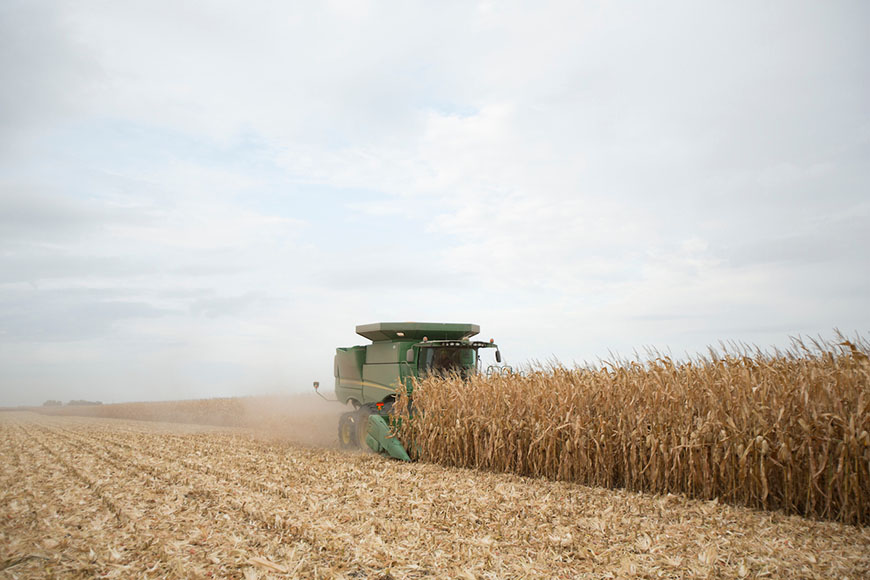8 Tips for Corn Harvest Success

As another growing season nears its end and you’re busy with a million different things, is there anything you can do to help ensure an orderly corn harvest? Here are some tips that could help you keep things on track.
1. Make sure your equipment is prepped and ready.
Have your machines serviced or repaired if necessary, in place and ready to go. This includes your combine, tractor, grain cart, trucks, augers and bins.
2. Know your marketing strategy and plan accordingly.
For example, if you have a contract to fill at a particular grain elevator, what is your plan for taking corn from a field that’s closer to that destination versus filling your own grain bin with corn from a field that’s closer to home? Know the logistics about what contracts you need to deliver on.
3. Calibrate your yield monitor.
Accuracy matters. If you’re using your data to evaluate hybrid performance or do a fertility trial, for example, making sure your monitor is calibrated correctly will give you the most accurate results and help you make the best determination on how a particular product performed.
4. Know your hybrids and have a plan of attack.
Which products are going to dry down first that you’ll want to get to right away? Depending on the situation, decide if you want to harvest damaged fields first before any more of the crop is compromised, or harvest your good corn first while it is healthy and leave poorer crops until the end.
5. Know the quirks of your fields.
Are there certain fields that present harvest challenges — for example, those with wet, low spots? Make sure you harvest those before rain or snow comes. Otherwise, it will be a challenge to ever get the corn crop out of that field.
6. Recheck equipment when you’re in the field.
Make sure you’re cleaning the grain off the ears correctly and you’re not throwing too many kernels out the back end of the combine.
7. Clean your equipment thoroughly.
It’s a no-brainer to clean equipment at the end of the season, but are you cleaning machinery in between fields? Combines can transfer diseases that overwinter in crop residue, such as Goss’s wilt, from field to field if you’re not cleaning them. It’s the same story with seeds from herbicide-resistant weeds.
8. Take notes.
Don’t rely on your memory; write down in-field observations. Capture them electronically or use a trusty paper and pencil.
1. Make sure your equipment is prepped and ready.
Have your machines serviced or repaired if necessary, in place and ready to go. This includes your combine, tractor, grain cart, trucks, augers and bins.
2. Know your marketing strategy and plan accordingly.
For example, if you have a contract to fill at a particular grain elevator, what is your plan for taking corn from a field that’s closer to that destination versus filling your own grain bin with corn from a field that’s closer to home? Know the logistics about what contracts you need to deliver on.
3. Calibrate your yield monitor.
Accuracy matters. If you’re using your data to evaluate hybrid performance or do a fertility trial, for example, making sure your monitor is calibrated correctly will give you the most accurate results and help you make the best determination on how a particular product performed.
4. Know your hybrids and have a plan of attack.
Which products are going to dry down first that you’ll want to get to right away? Depending on the situation, decide if you want to harvest damaged fields first before any more of the crop is compromised, or harvest your good corn first while it is healthy and leave poorer crops until the end.
5. Know the quirks of your fields.
Are there certain fields that present harvest challenges — for example, those with wet, low spots? Make sure you harvest those before rain or snow comes. Otherwise, it will be a challenge to ever get the corn crop out of that field.
6. Recheck equipment when you’re in the field.
Make sure you’re cleaning the grain off the ears correctly and you’re not throwing too many kernels out the back end of the combine.
7. Clean your equipment thoroughly.
It’s a no-brainer to clean equipment at the end of the season, but are you cleaning machinery in between fields? Combines can transfer diseases that overwinter in crop residue, such as Goss’s wilt, from field to field if you’re not cleaning them. It’s the same story with seeds from herbicide-resistant weeds.
8. Take notes.
Don’t rely on your memory; write down in-field observations. Capture them electronically or use a trusty paper and pencil.


